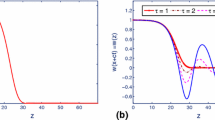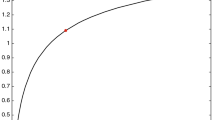Abstract
Biological invasion, whereby populations of motile and proliferative individuals lead to moving fronts that invade vacant regions, is routinely studied using partial differential equation models based upon the classical Fisher–KPP equation. While the Fisher–KPP model and extensions have been successfully used to model a range of invasive phenomena, including ecological and cellular invasion, an often-overlooked limitation of the Fisher–KPP model is that it cannot be used to model biological recession where the spatial extent of the population decreases with time. In this work, we study the Fisher–Stefan model, which is a generalisation of the Fisher–KPP model obtained by reformulating the Fisher–KPP model as a moving boundary problem. The nondimensional Fisher–Stefan model involves just one parameter, \(\kappa \), which relates the shape of the density front at the moving boundary to the speed of the associated travelling wave, c. Using numerical simulation, phase plane and perturbation analysis, we construct approximate solutions of the Fisher–Stefan model for both slowly invading and receding travelling waves, as well as for rapidly receding travelling waves. These approximations allow us to determine the relationship between c and \(\kappa \) so that commonly reported experimental estimates of c can be used to provide estimates of the unknown parameter \(\kappa \). Interestingly, when we reinterpret the Fisher–KPP model as a moving boundary problem, many overlooked features of the classical Fisher–KPP phase plane take on a new interpretation since travelling waves solutions with \(c < 2\) are normally disregarded. This means that our analysis of the Fisher–Stefan model has both practical value and an inherent mathematical value.










Similar content being viewed by others
References
Bate AM, Hilker FM (2019) Preytaxis and travelling waves in an eco-epidemiological model. Bull Math Biol 81:995–1030
Browning AP, McCue SW, Simpson MJ (2017) A Bayesian computational approach to explore the optimal the duration of a cell proliferation assay. Bull Math Biol 79:188–1906
Browning AP, Haridas P, Simpson MJ (2019) A Bayesian sequential learning framework to parameterise continuum models of melanoma invasion into human skin. Bull Math Biol 81:676–698
Buenzli PR, Lanaro M, Wong C, McLaughlin MP, Allenby MC, Woodruff MA, Simpson MJ (2020) Cell proliferation and migration explain pore bridging dynamics in 3D printed scaffolds of different pore size. Acta Biomater 114:285–295
Byrne HM (2010) Dissecting cancer through mathematics: from the cell to the animal model. Nat Rev Cancer 10:221–230
Cai AQ, Landman KA, Hughes BD (2007) Multi-scale modeling of a wound-healing cell migration assay. J Theor Biol 245:576–594
Canosa J (1973) On a nonlinear diffusion equation describing population growth. IBM J Res Dev 17:307–313
Chaplain MAJ, Lorenzi T, Mcfarlane FR (2020) Bridging the gap between individual-based and continuum models of growing cell populations. J Math Biol 80:343–371
Courchamp F, Berec L, Gascoigne J (2008) Allee effects in ecology and conservation. Oxford University Press, Oxford
Crank J (1987) Free and moving boundary problems. Oxford University Press, Oxford
Curtin L, Hawkins-Daarud A, van der Zee KG, Swanson KR, Owen MR (2020) Speed switch in glioblastoma growth rate due to enhanced hypoxia-induced migration. Bull Math Biol 82:43
Dalwadi MP, Waters SL, Byrne HM, Hewitt IJ (2020) A mathematical framework for developing freezing protocols in the cryopreservation of cells. SIAM J Appl Math 80:657–689
Du Y, Lin Z (2010) Spreading-vanishing dichotomy in the diffusive logistic model with a free boundary. SIAM J Math Anal 42:377–405
Du Y, Lou B (2015) Spreading and vanishing in nonlinear diffusion problems with free boundaries. J Eur Math Soc 17:2673–2724
Du Y, Matano H, Wang K (2014a) Regularity and asymptotic behavior of nonlinear Stefan problems. Arch Ration Mech Anal 212:957–1010
Du Y, Matsuzawa H, Zhou M (2014b) Sharp estimate of the spreading speed determined by nonlinear free boundary problems. SIAM J Math Anal 46:375–396
Edelstein-Keshet L (2005) Mathematical models in biology. SIAM, Philadelphia
El-Hachem M, McCue SW, Jin W, Du Y, Simpson MJ (2019) Revisiting the Fisher–Kolmogorov–Petrovsky–Piskunov equation to interpret the spreading-extinction dichotomy. Proc R Soc A Math Phys Eng Sci 475:20190378
El-Hachem M, McCue SW, Simpson MJ (2020) A sharp-front moving boundary model for malignant invasion. Phys D Nonlinear Phenomena 412:132639
Fadai NT, Simpson MJ (2020) Population dynamics with threshold effects give rise to a diverse family of Allee effects. Bull Math Biol 82:74
Fife PC (1979) Long time behavior of solutions of bistable nonlinear diffusion equations. Arch Ration Mech Anal 70:31–36
Fisher RA (1937) The wave of advance of advantageous genes. Ann Eugenics 7:355–369
Flegg JA, Menon SN, Byrne HM, McElwain DLS (2020) A current perspective on wound healing and tumour-induced angiogenesis. Bull Math Biol 82:43
Gaffney EA, Maini PK (1999) Modelling corneal epithelial wound closure in the presence of physiological electric fields via a moving boundary formalism. IMA J Math Appl Med Biol 16:369–393
Haridas P, McGovern JA, McElwain DLS, Simpson MJ (2017) Quantitative comparison of the spreading and invasion of radial growth phase and metastatic melanoma cells in a three-dimensional human skin equivalent model. PeerJ 5:e3754
Haridas P, Browning AP, McGovern JA, McElwain DLS, Simpson MJ (2018) Three-dimensional experiments and individual based simulations show that cell proliferation drives melanoma nest formation in human skin tissue. BMC Syst Biol 12:34
Hill JM (1987) One-dimensional Stefan problems: an introduction. Longman Scientific & Technical, Harlow
Horgan FG (2009) Invasion and retreat: shifting assemblages of dung beetles amidst changing agricultural landscapes in central Peru. Biodivers Conserv 18:3519
Ibrahim K, Sourrouille P, Hewitt GM (2000) Are recession populations of the desert locust (Schistocerca gregaria) remnants of past swarms? Mol Ecol 9:783–791
Jin W, Shah ET, Penington CJ, McCue SW, Chopin LK, Simpson MJ (2016) Reproducibility of scratch assays is affected by the initial degree of confluence: experiments, modelling and model selection. J Theor Biol 390:136–145
Jin W, Shah ET, Penington CJ, McCue SW, Maini PK, Simpson MJ (2017) Logistic proliferation of cells in scratch assays is delayed. Bull Math Biol 79:1028–1050
Johnston ST, Shah ET, Chopin LK, McElwain DLS, Simpson MJ (2015) Estimating cell diffusivity and cell proliferation rate by interpreting IncuCyte ZOOM\(^{\rm TM}\) assay data using the Fisher-Kolmogorov model. BMC Syst Biol 9:38
Johnston ST, Ross JV, Biner BJ, McElwain DLS, Haridas P, Simpson MJ (2016) Quantifying the effect of experimental design choices for in vitro scratch assays. J Theor Biol 400:19–31
Johnston ST, Baker RE, McElwain DLS, Simpson MJ (2017) Co-operation, competition and crowding: a discrete framework linking Allee kinetics, nonlinear diffusion, shocks and sharp-fronted travelling waves. Sci Rep 7:42134
Keller EF, Segel LA (1971) Model for chemotaxis. J Theor Biol 30:225–234
Killengreen ST, Ims RA, Yoccoz NG, Bråthen KA, Henden J-A, Schott T (2007) Structural characteristics of a low Arctic tundra ecosystem and the retreat of the Arctic fox. Biol Conserv 135:459–472
Kolmogorov AN, Petrovskii PG, Piskunov NS (1937) A study of the diffusion equation with increase in the amount of substance, and its application to a biological problem. Moscow Univ Math Bull 1:1–26
Kot M (2003) Elements of mathematical ecology. Cambridge University Press, Cambridge
Lewis MA, Kareiva P (1993) Allee dynamics and the spread of invading organisms. Theor Popul Biol 43:141–158
Maini PK, McElwain DLS, Leavesley DI (2004a) Traveling wave model to interpret a wound-healing cell migration assay for human peritoneal mesothelial cells. Tissue Eng 10:475–482
Maini PK, McElwain DLS, Leavesley D (2004b) Traveling waves in a wound healing assay. Appl Math Lett 17:575–580
McCue SW, Jin W, Moroney TJ, Lo K-Y, Chou SE, Simpson MJ (2019) Hole-closing model reveals exponents for nonlinear degenerate diffusivity functions in cell biology. Phys D Nonlinear Phenomena 398:130–140
McCue SW, El-Hachem M, Simpson MJ (2021) Exact sharp-fronted travelling wave solutions of the Fisher-KPP equation. Appl Math Lett. 114:106918. https://doi.org/10.1016/j.aml.2020.106918
Mitchell SL, O’Brien SBG (2014) Asymptotic and numerical solutions of a free boundary problem for the sorption of a finite amount of solvent into a glassy polymer. SIAM J Appl Math 74:697–723
Murray JD (1984) Asymptotic analysis. Springer, New York
Murray JD (2002) Mathematical biology I: an introduction, 3rd edn. Springer, New York
National Cancer Institute (1985) Melanoma
Otto G, Bewick S, Li B, Fagan WF (2018) How phenological variation affects species spreading speeds. Bull Math Biol 80:1476–1513
Painter KJ, Sherratt JA (2003) Modelling the movement of interacting cell populations. J Theor Biol 225:327–339
Painter KJ, Bloomfield JM, Sherratt JA, Gerish A (2015) A nonlocal model for contact attraction and repulsion in heterogeneous cell populations. J Math Biol 77:1132–1165
Sánchez Garduno F, Maini PK (1994) Traveling wave phenomena in some degenerate reaction–diffusion equations. J Differ Equ 117:281–319
Sengers BG, Please CP, Oreffo ROC (2007) Experimental characterization and computational modelling of two-dimensional cell spreading for skeletal regeneration. J R Soc Interface 4:1107–1117
Sherratt JA, Marchant BP (1996) Nonsharp travelling wave fronts in the Fisher equation with degenerate nonlinear diffusion. Appl Math Lett 9:33–38
Sherratt JA, Murray JD (1990) Models of epidermal wound healing. Proc R Soc Lond Ser B 241:29–36
Simpson MJ, Landman KA, Clement TP (2005) Assessment of a non-traditional operator split algorithm for simulation of reactive transport. Math Comput Simul 70:44–60
Simpson MJ, Zhang DC, Mariani M, Landman KA, Newgreen DF (2007) Cell proliferation drives neural crest cell invasion of the intestine. Dev Biol 302:553–568
Simpson MJ, Treloar KK, Binder BJ, Haridas P, Manton KJ, Leavesley DI, McElwain DLS, Baker RE (2013) Quantifying the roles of motility and proliferation in a circular barrier assay. J R Soc Interface 10:20130007
Sinkins PA, Otfinowski R (2012) Invasion or retreat? The fate of exotic invaders on the northern prairies, 40 years after cattle grazing. Plant Ecol 213:1251–1262
Skellam JG (1951) Random dispersal in theoretical populations. Biometrika 38:196–218
Strobl MAR, Krause AL, Damaghi M, Gillies R, Anderson ARA, Maini PK (2020) Mix and match: phenotypic coexistence as a key facilitator of cancer invasion. Bull Math Biol 82:15
Swanson KR, Bridge C, Murray JD, Alvord EC Jr (2003) Virtual and real brain tumors: using mathematical modeling to quantify glioma growth and invasion. J Neurol Sci 216:1–10
Taylor CM, Hastings A (2005) Allee effects in biological invasions. Ecol Lett 8:895–908
Tsoularis A, Wallace J (2002) Analysis of logistic growth models. Math Biosci 179:21–55
Warne DJ, Baker RE, Simpson MJ (2019) Using experimental data and information criteria to guide model selection for reaction–diffusion problems in mathematical biology. Bull Math Biol 81:1760–1804
Witelski TP (1995) Merging traveling waves for the Porous–Fisher’s equation. Appl Math Lett 8:57–62
Acknowledgements
We thank Stuart Johnston, Sean McElwain and two anonymous referees for helpful suggestions and feedback. This work is supported by the Australian Research Council (DP200100177).
Author information
Authors and Affiliations
Corresponding author
Ethics declarations
Conflict of interest
The authors declare that they have no conflict of interest.
Additional information
Publisher's Note
Springer Nature remains neutral with regard to jurisdictional claims in published maps and institutional affiliations.
Rights and permissions
About this article
Cite this article
El-Hachem, M., McCue, S.W. & Simpson, M.J. Invading and Receding Sharp-Fronted Travelling Waves. Bull Math Biol 83, 35 (2021). https://doi.org/10.1007/s11538-021-00862-y
Received:
Accepted:
Published:
DOI: https://doi.org/10.1007/s11538-021-00862-y




